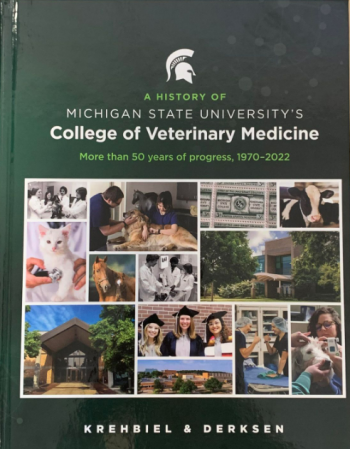For the past several years, Drs. Janver Krehbiel and Frederik Derksen have been working on a history book about the Michigan State University College of Veterinary Medicine. Through many days, months, and years spent researching the College and conducting interviews, Krehbiel and Derksen were able to craft a 15-chapter book that details College leadership, research, diagnostics, and more. In celebration of the completion of the book, Krehbiel and Derksen shared a little bit about the writing process and what they’ve learned in this endeavor.
Why did you decide to write the book?

The idea of this history book was born many years ago when the authors were still on the faculty. At that time, we discussed the book Veterinary Medicine in Michigan, An Illustrated History written by Dr. Charles Cleon Morrill. The book covered the history of the College of Veterinary Medicine at Michigan State University through the 1970s. We commented that since that time, the College had advanced enormously, and that both of us were proud of having been part of the college’s successes and accomplishments. We agreed that, because of the significance of the College in veterinary medicine and its contributions to research, education, and clinical practice, this progress should be captured before it is lost to history. Many years passed, and about three years ago, we reconnected and discussed the same issue. We decided that, not getting any younger, now was the time to get this book written before institutional memory was lost.
What was the writing process like?
The writing process started by first determining the important subjects to be covered. This process resulted in the decision to write 15 chapters on subjects such as college leadership; faculty, staff, and students; facilities; curriculum; research; endowed chairs and professorships; clinical and diagnostic activities; international programs; and the COVID-19 pandemic. We gathered as many documents as were available, including accreditation self-studies, academic program books, lists of graduates and award recipients, publications, as well as photographs. We then interviewed many faculty, staff, administrators, students, alumni, donors, and friends of the College, who often contributed substantially to the writing of the manuscript. In this manner, we hoped to capture the collective institutional memory of those who contributed to the success of the College. We are very grateful to those who helped us write the book for generously sharing their time and expertise. Together, the authors have walked the halls of this institution for a collective 85+ years. Therefore, together we had significant institutional memory that provided context.
During the writing process, we had significant support from the College, including the Communications and Development teams. By weaving together historical events, anecdotes, and key figures, we attempted to write the book as a cohesive narrative. We aspired to maintain a balance between thorough research and engaging storytelling to make the history of the College come to life for readers. Overall, the writing of this book was truly fun. It allowed us to reconnect with colleagues and friends and to revisit the numerous achievements and successes of the College. Writing the book was a labor of love.
Did you learn anything particularly interesting or surprising when writing the book?
Having been faculty members in the College for a collective 85+ years, we assumed that we knew most of the important accomplishments of the College. This turned out not to be the case. Our extensive research and interviews revealed many more accomplishments and successes than we originally knew about. The College’s prowess in innovative teaching and clinical activities, and impactful research are truly astonishing and made us even more proud of having been part of this exceptional institution. It also reminded us of the individuals who made the College so successful over the last half-century. Their dedication, passion, and commitment have truly made the College the success that it is today.
What do you hope readers take away from the book?

First and foremost, we hope that the readers enjoy reading the book and are reminded of their roles in the College’s success. Furthermore, we hope that the readers gain a deep appreciation of the advancements, challenges, and contributions made by the College. Throughout its history, the College has played a pivotal role in shaping veterinary medicine, both locally and globally, influencing not only animal health, but also human health and the environment. Finally, we hope that this book will be an inspiration for the current and future College of Veterinary Medicine family to aspire for greatness, reach high, dream big, and understand the infinitude of yet unimagined possibilities.
Now that you’ve written the book, how would you describe what makes the College special?
The College is special because of its people; it has been blessed with faculty, staff, and students whose dedication and hard work have advanced the field of veterinary medicine and have made the world a better place. The College is also special because of its alumni. They have carried MSU’s veterinary legacy far and wide. Their collective impact on the veterinary profession and animal well-being serves as a testament to the enduring strength of the education they received. Finally, the College is fortunate to have such numerous and generous animal lovers, donors, and friends. They have created a margin of excellence that would not have been possible without their support.
Is there anything else you’d like to share about the book or the process of creating it?
As we reflect on the progress made over the past 50 years, we are reminded that the story of veterinary medicine at Michigan State University is one of continuous growth and progress. This book stands not only as a tribute to the advancements of the past, but also as a testament to the boundless possibilities that lie ahead.
Buy the Book